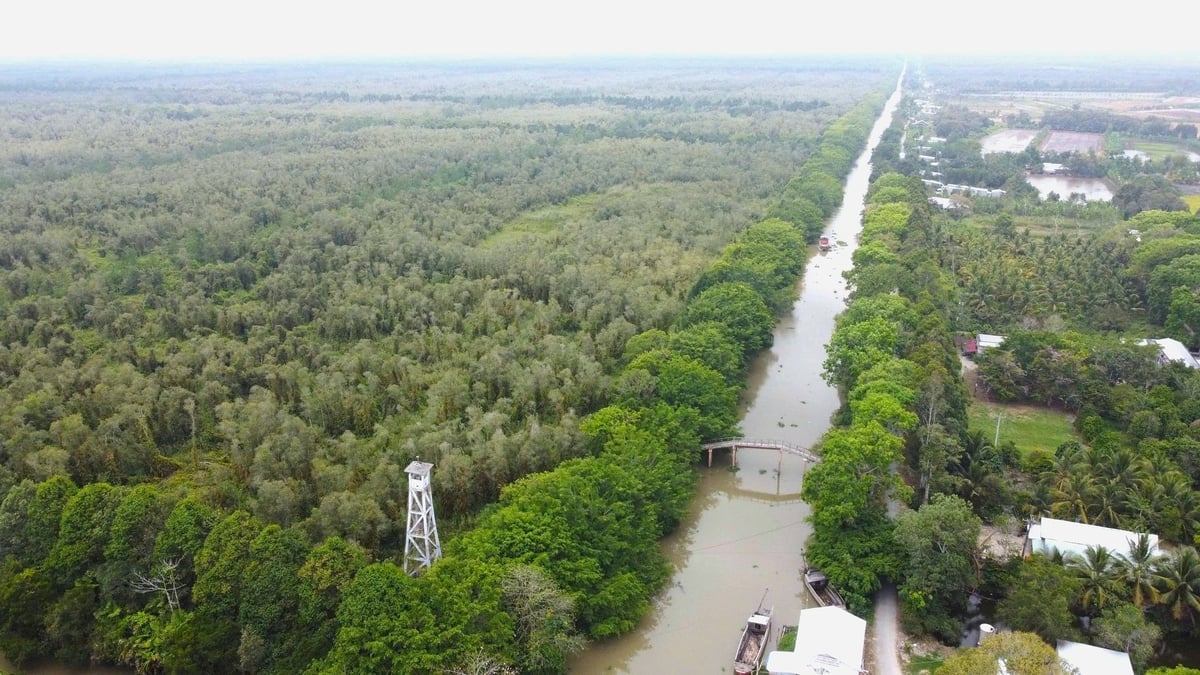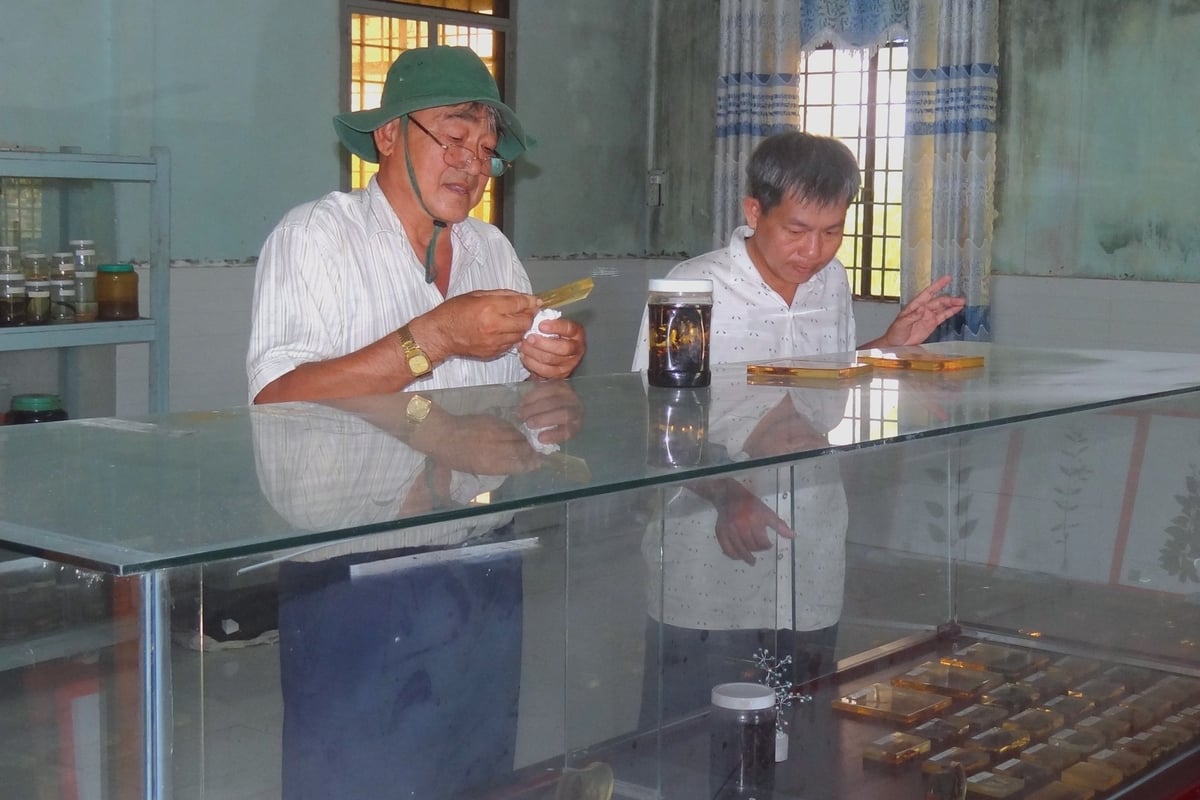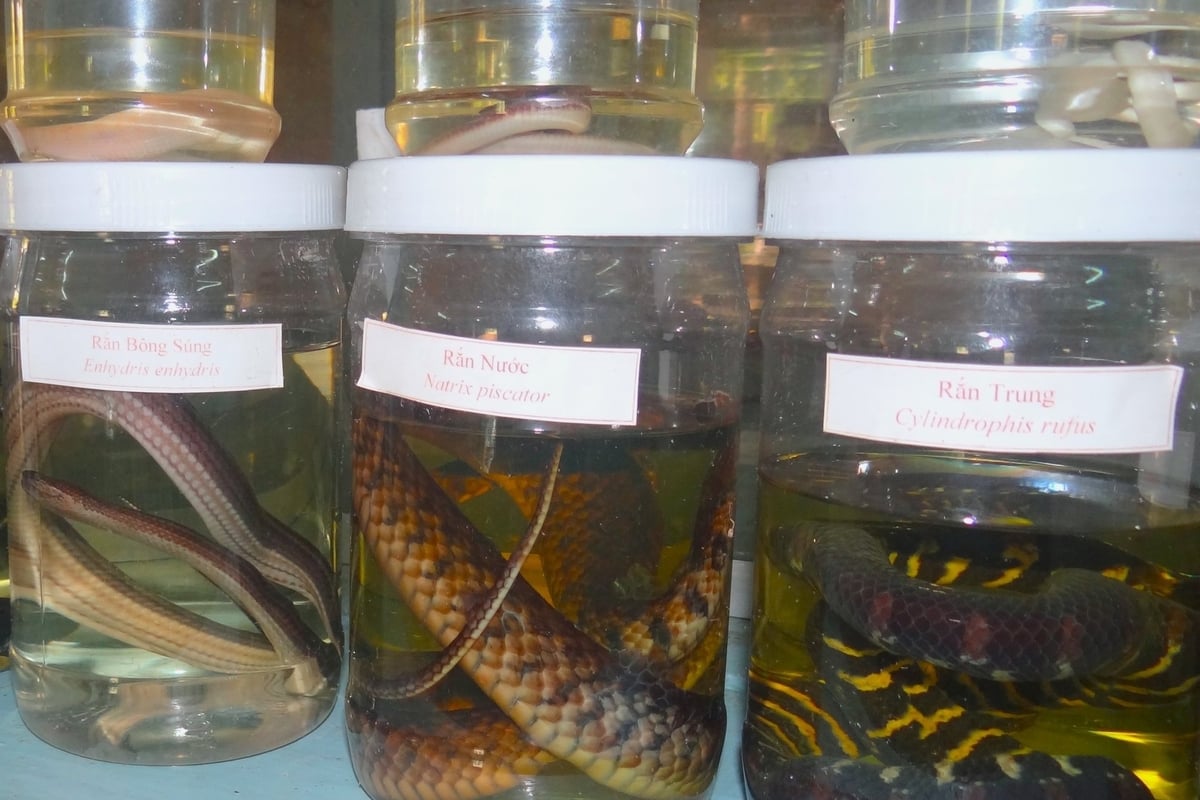October 28, 2025 | 18:14 GMT +7
October 28, 2025 | 18:14 GMT +7
Hotline: 0913.378.918
October 28, 2025 | 18:14 GMT +7
Hotline: 0913.378.918
Lung Ngoc Hoang Nature Reserve, located in Phuong Hoa Hamlet, Phuong Binh Commune, Can Tho City, spans approximately 2,800 hectares and is a prime example of a wetland in the Lower Hau River region. This area currently safeguards over 330 plant species and 206 animal species, many of which are rare and listed in both the Vietnam Red Book and global Red Lists.
With its unique habitat, Lung Ngoc Hoang serves as a repository for characteristic ecosystems, playing a vital role in conserving native, endemic, and rare species in the Mekong Delta.

The Lung Ngoc Hoang Nature Reserve is often called the "green lung" of the Mekong Delta. Photo: Van Vu.
The Department of Science and Wetland Conservation (under the Lung Ngoc Hoang Nature Reserve) has implemented numerous scientific research projects closely tied to resource management and conservation. A notable project is "Scientific Research and Technology Development for Surveying the Current Status of Flora and Fauna in Lung Ngoc Hoang Nature Reserve”.
Mr. Tran Be Em, Head of the Department of Science and Wetland Conservation, stated that this project has facilitated the timely addition of new species to the plant catalog and the removal of species no longer suited to the reserve's ecological conditions. It has also documented information on many characteristic animal species of the wetland ecosystem.
Since 2015, surveys have recorded an additional 981 plant species belonging to 26 genera and 19 families, 126 bird species, and 85 fish species. Of these, 11 fish species were added to the reserve's catalog. Several waterbird species have been observed in large numbers, thriving in the unique wetland areas of Lung Ngoc Hoang.
Furthermore, the research team discovered and added five new plant species to the catalog: members of the loosestrife, acanthaceae, legume, and castor bean families.
In parallel, the project "Basic Survey, Assessment of the Current Status of Biodiversity in Lung Ngoc Hoang Nature Reserve and Identification of Priority Biodiversity Conservation Issues" has been effectively implemented to monitor fluctuations in higher plants, fish, and bird species over time. The project's goal is to promptly discover new species while identifying those at risk of extinction to develop appropriate conservation plans, contributing to the preservation and development of valuable genetic resources.

Exhibit area at the Department of Science and Wetland Conservation (Lung Ngoc Hoang Nature Reserve). Photo: Kim Anh.
Another direction emphasized by the Lung Ngoc Hoang Nature Reserve Management Board is the establishment of a medicinal plant catalog and the development of a traditional Vietnamese medicine garden. This model not only serves medical research but is also part of a sustainable biodiversity conservation strategy.
Mr. Le Thanh Son, Deputy Director in charge of Lung Ngoc Hoang Nature Reserve, noted that through scientific research and conservation activities, the unit is progressively building a biodiversity database to store necessary information. Simultaneously, they are intensifying research on factors affecting the growth and development of melaleuca forests. The research results will provide a scientific basis for future forest conservation, fire prevention, and sustainable forest ecosystem management.
The Lung Ngoc Hoang area was once a wild, perennially flooded land with sparse human habitation. Before 1975, it was a dense natural ecosystem of reeds, teeming with abundant birds and fish.
In 2021, the Hau Giang Provincial People's Committee (before its merger into Can Tho City) approved the land use plan for Lung Ngoc Hoang Nature Reserve. Specifically, after transferring 38.5 hectares to local management, Lung Ngoc Hoang Nature Reserve retained 2,762 hectares. This area is divided into three zones: a strictly protected zone of 1,001 hectares, an ecological restoration zone of 929 hectares, and an administrative service zone of 832 hectares.
The strictly protected zone is the core area, featuring pristine landscapes and high biodiversity. Therefore, this zone is rigorously protected to minimize human impact, aiming to conserve wild and endemic flora and fauna genetic resources. This zone is currently home and nesting ground for wild birds, forest animals, aquatic species, and rare native aquatic products such as little egret, purple swamphen, Asian openbill, painted stork, grey heron, fruit bat, otter, ferret-badger, civet, mangrove monitor, softshell turtle, yellow-headed temple turtle, and Asian bullfrog.

Some rare animal specimens preserved at Lung Ngoc Hoang Nature Reserve for scientific research. Photo: Van Vu.
The ecological restoration zone is primarily used for research, experimentation, and the restoration of swamp ecosystems, featuring many tree species like gao (nauclea), tram (Eugenia), o moi (cassia), cong (Albizia lebbeck), and dung dinh (Arenga pinnata). Notably, there is also a 0.4-hectare 40-year-old melaleuca forest with many traces of valuable animals such as pythons, reticulated pythons, and hundreds of naturally occurring beehives.
Mr. Le Thanh Son added that the unit regularly conducts surveys, observations, and monitoring of flora and fauna to update the database for management. They also monitor the appearance of potentially invasive alien species, manage medicinal plant diversity, and compile a catalog of butterflies and insects in the area.
Additionally, the Reserve Management Board collaborates closely with specialized agencies to promote nature conservation and organize activities to release native and rare aquatic and wild animals back into their natural environment, restoring and stabilizing the ecosystem.
During a field survey in July 2022, Prime Minister Pham Minh Chinh assessed Lung Ngoc Hoang Nature Reserve as a rare asset of Hau Giang province (formerly) and the Mekong Delta in general. The reserve holds not only ecological and natural value but is also linked to a heroic revolutionary history, serving as a revolutionary base area. The Prime Minister urged local authorities to preserve and protect the pristine forest and its environment rigorously, scientifically, and effectively.
Currently, forest protection contracts, biodiversity restoration, and scientific research activities at Lung Ngoc Hoang continue to be maintained and expanded. This is considered the right approach to preserve one of the distinctive habitats in the Southwest region.

Lung Ngoc Hoang Nature Reserve currently has multiple zones performing functions of protection and natural ecosystem restoration. Photo: Kim Anh.
Forest conservation and natural resource protection are not only legal responsibilities but also a strategic choice in sustainable development. Over time, Lung Ngoc Hoang continues to quietly grow and develop, gradually affirming its position as a special wetland on Vietnam's ecological map.
Translated by Linh Linh

(VAN) The Integrated Plant Health Management (IPHM) helps farmers in Quang Ngai increase rice production efficiently and sustainably.

(VAN) Developing low-emission cultivation technology packages, MRV system, strengthening multi-stakeholder cooperation are to realize the goal of low-emission crop production.
/2025/10/23/5928-2-194850_964.jpg)
(VAN) The 'Regenerative cocoa production to support livelihood development in Vietnam' (ReCoPro) project marks an important step toward sustainable cocoa production.

(VAN) Reducing antibiotic dependence in livestock production helps protect public health, enhance food safety, and promote sustainable agricultural development.

(VAN) Experts describe Viet Nam as a 'policy laboratory' within ASEAN, where new agroecological, green finance, and risk-management initiatives are being piloted before wider regional adoption.

(VAN) Limiting rice straw burning and reusing agricultural by-products as materials or fertilizers not only improves soil health but also helps clean the air.

(VAN) ASSET delivers long-term vision and strategy, innovative models, learning networks, policy impact, and measurable environmental benefits.